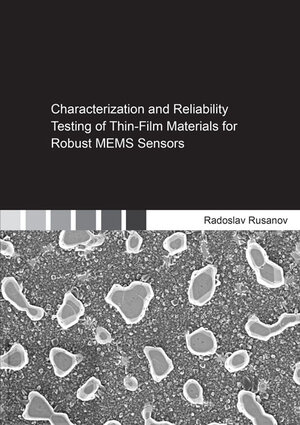
×
![Buchcover ISBN 9783844042603]()
Characterization and Reliability Testing of Thin-Film Materials for Robust MEMS Sensors
von Radoslav RusanovMEMS sensors are widely applied in modern combustion engine vehicles due to their precision and reliability, their small size and cost efficiency. Harsh environments like the combustion chamber or the exhaust gas system of the car are a new challenge for MEMS-based sensors. In order for them to perform under such harsh conditions new thermally, chemically and mechanically stable thin films are necessary. The material properties of such custom-specifically developed thin layers need to be determined in order to enable the sensor's design and optimization and ensure its reliability over the required lifetime.
High temperature material characterization and reliability testing methods have been developed for the three material systems studied in this thesis with different testing aims. The thermal conductivity and capacity of SiO2 deposited with PECVD have been measured using structures consisting of a silicon oxide stripe stacked between two platinum stripes. For the electrical and mechanical characterization of LPCVD SiC a set of test structures including Van der Pauw and Circular Transition Length methods and electrostatically driven cantilever devices have been developed and successfully applied. The most important feature of both the thermal and mechanical test structures is that they are driven and read-out purely electrically which allows the characterization of a large number of samples in a short time. FIB cuts and SEM imaging, XPS and XRD analysis and resistivity measurements have been applied on platinum in order to study the grain structure evolution and diffusion processes at elevated temperatures. The process of electromigration has been studied qualitatively and quantitatively so that the lifetime of platinum heater elements can be predicted.
High temperature material characterization and reliability testing methods have been developed for the three material systems studied in this thesis with different testing aims. The thermal conductivity and capacity of SiO2 deposited with PECVD have been measured using structures consisting of a silicon oxide stripe stacked between two platinum stripes. For the electrical and mechanical characterization of LPCVD SiC a set of test structures including Van der Pauw and Circular Transition Length methods and electrostatically driven cantilever devices have been developed and successfully applied. The most important feature of both the thermal and mechanical test structures is that they are driven and read-out purely electrically which allows the characterization of a large number of samples in a short time. FIB cuts and SEM imaging, XPS and XRD analysis and resistivity measurements have been applied on platinum in order to study the grain structure evolution and diffusion processes at elevated temperatures. The process of electromigration has been studied qualitatively and quantitatively so that the lifetime of platinum heater elements can be predicted.


